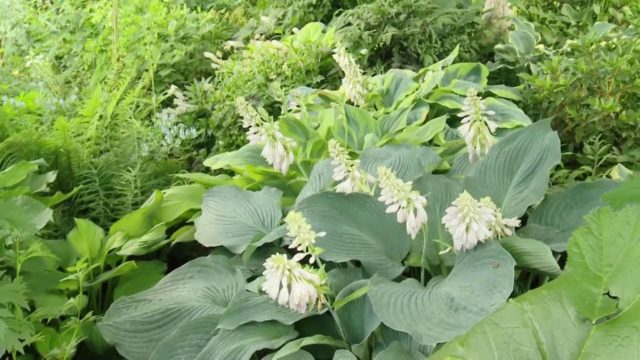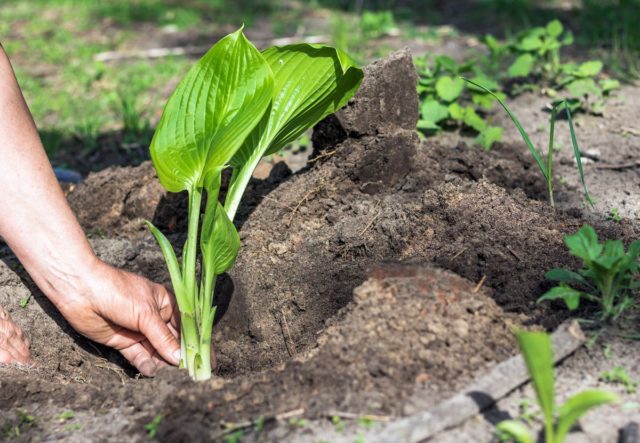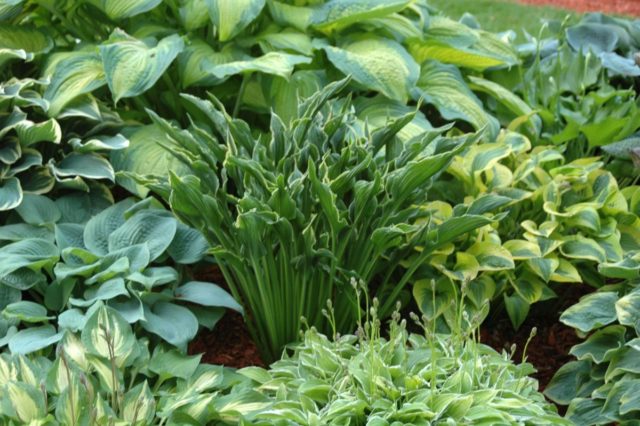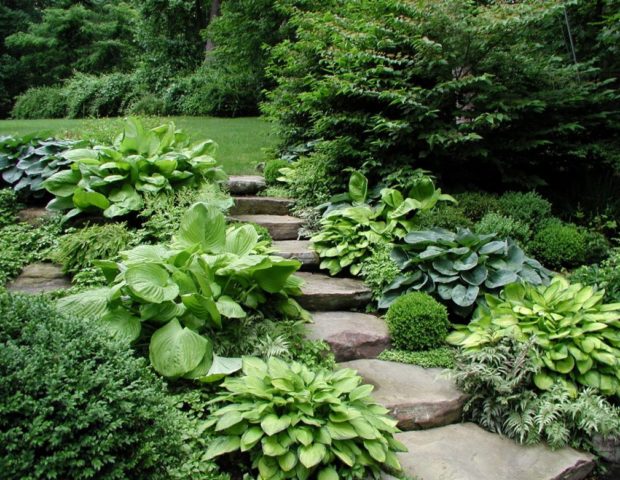Content
Hosta is appreciated for its decorative qualities and shade tolerance, so that for it you can choose shady areas of the garden where other flowers do not grow well. But even in such places, they will be clearly visible. For example, the Blue Angel hosta has blue leaves that stand out from the greenery of other plants. Not a single florist will refuse to plant this variety on his site. A description of the plant and an understanding of its agricultural technology will help to properly plant and grow this bush in a backyard or summer cottage.
Description of Blue Angel hosts
The Blue Angel variety was bred by a breeder from Holland in 1986. It is distinguished by frost resistance, unpretentiousness, resistance to infections and many pests, it can grow without transplanting in one place for many years. It is able to withstand short-term drying out or flooding, does not make high demands on air purity, so it can be planted not only outside the city, but also within it. The Blue Angel variety is recommended for cultivation in the regions of Central Russia, well adapted to temperate climates.
In the description of the Blue Angel hosta, it is indicated that its height is 0.7-0.8 m, but if excellent conditions are created, it can grow up to 0.9-1 m.In diameter, the bush is voluminous, equal to 1.2 m.Leaves are large, 0.4 m long and 0.3 m wide, dark blue (turning green by autumn), the tips are directed downward. The surface of the leaf blade is slightly wrinkled, with parallel light-colored veins. Flowers of Blue Angel hosts are collected in racemose cone-shaped inflorescences. Their color can be varied, ranging from white to pale lavender. Peduncles are erect, strong. Long bloom, falls in July-August.
The Blue Angel variety is shade-tolerant, can grow without problems in the shade, partial shade or in diffused light. If you plant hosts in an open area, there is a possibility of burns on the leaves. The ideal planting site is under the crowns of trees, where the plants will be protected from too bright light and strong winds.
Hosts of the Blue Angel variety are moisture-loving, for normal growth and development they need moist, but well-drained soils, loose and with a full layer of humus. They grow worse on dry sandy soils, as well as on acidic or alkaline ones.

Hosta Blue Angel prefers neutral or slightly alkaline soil
Application in landscape design
Against the background of a host with solid leaves, like the Blue Angel variety, other plants look good, for example, peonies, ferns, astilbe, conifers. Daylilies, kupins, phloxes, ornamental cereals can be planted next to them.
Breeding methods
In one place, Blue Angel hosts can grow for about 10 years. If necessary, it is easiest and fastest to multiply them by dividing them. You can divide it during the entire growing season, but it is better to do this not earlier than the end of August. At this time, new growth buds are formed in the plants, they become clearly visible, which makes it easy to divide the bush correctly.
You can also choose any summer day for grafting hosts. It is necessary to separate young shoots with a small piece of rhizome from the bush and plant them in a shaded place in damp ground.
If necessary, Blue Angel hosts can be propagated by seeds.They germinate well, but the plants grown from them will develop slowly and the characteristic size for the variety can only reach 4 or 5 years of age.

It is best to reproduce hosts by dividing the bush
Landing algorithm
Young Blue Angel hosts suitable for planting should be healthy and well developed, with fresh roots and shoots. Instances on which traces of diseases or pests will be noticed should not be planted.
In nature, hosts grow in the shade of trees; in the garden, they also need to create similar conditions. But they can be placed not only under trees, but also near fences, buildings, along paths, near water bodies. The main thing is that the site is not in direct sunlight and is protected from gusty winds.
Blue Angel hosts are planted at a distance of 1 m from each other, since the bushes are quite large and spreading. The size of the landing pits should be approximately 0.4 m in diameter. A drainage layer must be laid down, a fertile mixture of organic matter and extracted earth is poured on top. The seedling is placed in the center, sprinkled with soil, watered. It is advisable to mulch the soil surface already on the day of planting, in order to reduce the evaporation of moisture. This will help the plant take root faster.
Growing rules
Hosts, including Blue Angel, are considered unpretentious. Most of all they need moisture, and mainly after planting, when rooting takes place. That is why it is so important to water them on time during the first month, until the seedling has new roots. Adult hosta bushes also need watering, especially on hot days. In this case, you need to ensure that water does not fall on the surface of the leaves (burns may appear in the place of moisture droplets), it should be poured only under the root. In wet seasons, watering is not necessary - despite the moisture-loving nature, the culture does not like too damp soil.
It is not required to feed Blue Angel plants in the first year after planting. In the future, they are fertilized:
- early spring, when new stems begin to grow;
- before flowering;
- after its completion.
Fertilizers are used standard: organic matter (humus, ash, compost) or mixtures of mineral origin. The amount of fertilizer applied should be moderate, overfed hosts become more susceptible to fungal diseases, grow lush foliage, but bloom poorly.
Experienced florists advise to cut off all flower stalks after the completion of the flowering of Blue Angel plants. This will prevent the seeds from setting (if not needed) and allow the hosts to better prepare for the winter.

On one site, you can safely combine several varieties of hosts
Preparing for winter
Hosts of the Blue Angel variety are cold-resistant, therefore, theoretically, they do not need insulation for the winter. But in the first year, it is better to cover young plants, especially if they were planted in early autumn. Adult shrubs are sheltered only in regions with cold and long winters. Peat, sawdust, humus, fallen leaves, straw or old hay are suitable as a covering material. You can use lightweight but durable modern agrofibre. It will do its job just as well as proven organic materials.
As for pruning leaves, then flower growers have no unequivocal opinion on this matter. Some prune their plants in the fall, others in the spring. The former argue that pests hibernate under the leaves of the hosts, the latter claim that the leaves protect the roots from the cold. One way or another, you can prune in any of the indicated periods of the year.
Diseases and pests
The Blue Angel variety is considered resistant to pests and rarely gets sick (subject to the conditions of agricultural technology). Of the pests on it, you can only see slugs and snails. But they are capable of causing significant damage to plants. Mollusks reproduce especially quickly in wet weather, so on rainy and cool days, you need to inspect the bushes in order to identify pests in time.
Slugs and snails are quite large and noticeable, if there are few bushes, they can simply be collected by hand.Simple traps will help: raw boards laid out next to the bushes, pieces of glass or slate. Pests are always taken under them, where they are easy to detect and destroy. And so that they do not get to the plants, it is recommended to sprinkle the ground around with mustard powder, tobacco or just ash. Ashes will also serve as a good fertilizer.

If the hosta has too many leaves, they can be thinned for better ventilation.
Conclusion
Hosta Blue Angel is a representative of the blue varieties group. It is well known to culture lovers, but it also attracts newcomers. Hosta is equally decorative both on its own and in composition with completely different colors. That is why it can be chosen for landscaping any site.








